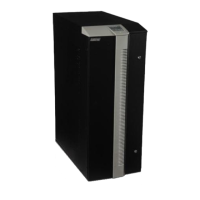3
STATIC TRANSFER SWITCH (STATIC BYPASS) : This is an electronically controlled transfer switch, which
enables the critical load to be connected either to inverter output or to a by-pass power source. During normal
operation, the load is supplied by the inverter output, but in case of an overload it is automatically transferred
to the bypass source without any interruption.
MAINTENANCE BYPASS SWITCH (MBS) : This is a manually controlled mechanical switch, which is used to
supply the critical load, using the bypass source, when the UPS is shut down for maintenance or
troubleshooting purposes.
The load is unprotected against mains supply disturbances and black-outs when it is connected to either static
or maintenance bypass supply.
1.3.1 OPERATING MODES OF UPS
PDSP series UPSs are capable of operating in various different modes for maximum application flexibility.
These modes are:
- ONLINE mode: This is the normal operation mode for a single UPS. As long as the mains supply is
available and in required tolerances, the load is supplied by the well regulated inverter output and the
batteries are charged at the same time. In case of mains failure, the inverter keeps supplying the load
using the energy stored in the batteries.
- ECO-mode: This is the off-line operation mode for a single UPS. As long as the mains supply is
available and in required tolerances, the load is supplied by the mains supply (bypass supply) via the
Static Bypass Switch of the UPS and the batteries are charged at the same time. During that time
inverter keeps running under no-load conditions and takes over the load in case of a mains supply
(bypass supply) failure, without any interruption. After restoration of the mains supply the load is
transferred back to bypass supply again.
- PARALLEL, REDUNDANT and N+1 REDUNDANT modes are used for parallel operation of two or
more UPS units and will be explained in parallel operation section later in this manual.
When operating in one of the above operating modes, UPS may be in one of the following operating
conditions:
A. Normal Operation (If Mains supply is available):
All fuses and power switches are closed (except the Maintenance Bypass Switch), and the load is supplied
by the Inverter Output. During normal operation, the Rectifier supplies DC power to the Inverter and
charges the Batteries at the same time.
B. Battery Operation :
The Batteries are connected to the Rectifier output. In case of a mains failure (mains power outage or AC
input voltage out of tolerance), the Rectifier stops operating and the DC voltage necessary for the inverter
operation is supplied by the batteries. Therefore the AC voltage output supplying the critical load is not
interrupted, until the batteries are fully discharged. At the end of the discharging time the Inverter is turned
off and it start again automatically, together with the Rectifier, when the mains power is restored, and the
UPS returns o normal operation.
The Rectifier is also turned off and Inverter operates on batteries during automatic or manual battery test
procedure.
C. By-Pass Operation :
If the Inverter output is overloaded or in case of a problem in the UPS, the static switch transfers the load to
the bypass supply without any interruption, provided that the bypass supply is available and within the
tolerated limits.
At the end of the overloading period, if the fault condition is restored, static switch transfers the critical load
again to the inverter output. Note that, during operation from the bypass supply, the critical load may be
affected by any possible disturbances or power failure in the bypass supply.

